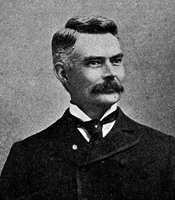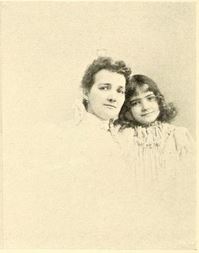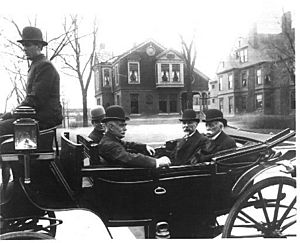William S. Linton facts for kids
Quick facts for kids
William S. Linton
|
|
|---|---|
 |
|
| Member of the U.S. House of Representatives from Michigan's 8th district |
|
| In office March 4, 1893 – March 3, 1897 |
|
| Preceded by | Henry M. Youmans |
| Succeeded by | Ferdinand Brucker |
| Member of the Michigan House of Representatives | |
| In office 1887–1888 |
|
| Personal details | |
| Born | February 4, 1856 St. Clair, Michigan |
| Died | November 22, 1927 (aged 71) Lansing, Michigan |
| Nationality | American |
| Political party | Republican |
| Alma mater | University of Michigan |
William Seelye Linton (born February 4, 1856 – died November 22, 1927) was an important politician from the state of Michigan in the United States. He served in the U.S. Congress and held several other public offices.
Contents
William Linton's Early Life and Education
William Linton was born in St. Clair, Michigan. When he was three years old, his family moved to Saginaw in 1859. There, he went to public schools.
Starting a Career in Lumber
As a young man, Linton worked as a clerk in a store in Farwell. He then became involved in the lumber industry. This work took place in a town called Wells, which is now known as Alger.
Early Political Roles
Linton served on the board of supervisors for Bay County for two terms. In 1878, he returned to Saginaw. He joined his father in the lumber business. He also worked in other business ventures.
In 1884 and 1885, he was a member of the common council in East Saginaw. He then served in the Michigan House of Representatives from 1887 to 1888. In 1892, he was elected mayor of Saginaw.
William Linton's Family Life
William Linton married Ida M. Lowry. She was from Romero, Michigan, but spent much of her life in Saginaw. They had three children together: Ray, a younger son, and Elsie, their only daughter.
William Linton's Political Career
In 1892, William Linton ran for the United States Congress. He was a member of the Republican Party. He won the election for Michigan's 8th congressional district. He defeated the person who was already in office, Henry M. Youmans.
Serving in Congress
Linton served in the 53rd United States Congress. He was re-elected in 1894 to the 54th Congress. His time in Congress lasted from March 4, 1893, to March 3, 1897. During the 54th Congress, he led the United States House Committee on Ventilation and Acoustics. In 1896, Linton lost his re-election bid to Ferdinand Brucker.
Developing a New Community in Florida
In 1895, Linton and a partner, David Swinton, visited Florida. They were looking for new business opportunities. They traveled south by boat from West Palm Beach. Linton and Swinton liked the area. They bought a large piece of land. This land is now much of Delray Beach and Boynton Beach.
They went back to Michigan to find people to settle the land. By the fall of 1895, eight settlers had agreed to move. A settlement called Linton was started within a year. The settlers cleared land, planted crops, and opened a post office and store.
Challenges and Changes in Florida
By 1897, Linton faced financial difficulties. He sold some of his land to Nathan Smith Boynton. This helped him raise money. However, by 1898, some of Linton's settlers faced problems with land ownership. They had believed Linton owned the land clearly. Some settlers returned north, and Linton's reputation was affected.
Linton returned to Michigan. The settlement in Florida was renamed Delray. It was named after Delray, Michigan. This was the hometown of W.W. Blackmer, one of the first settlers.
Later Public Service
On March 22, 1898, U.S. President William McKinley appointed Linton as postmaster of Saginaw. He served in this role until 1914. He was also president of the Saginaw Board of Trade from 1905 to 1911 and again from 1913 to 1917.
In 1914, he tried to become the Republican candidate for Governor of Michigan. However, he lost to Chase S. Osborn. In 1919, he was appointed to the Michigan State Board of Tax Commissioners. He became the secretary of this board a few weeks before he passed away. William Linton died in Lansing on November 22, 1927. He was buried in Forest Lawn Cemetery in Saginaw.
Images for kids





